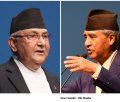When a Muslim gifted a chariot to Sikh Guru

![]() There is a historic chariot in the possession of Gurchet Singh at Bhai Roopa village near Rampura Phul in Bathinda district of Punjab. It is believed to have been taken there in 1744 by Bhai Gian Chand, a devotee of Ram Rai, son of Guru Hari Rai. Legend has it that Muslim craftsman from Kashmir presented the chariot to Guru Ram Das at Amritsar.
There is a historic chariot in the possession of Gurchet Singh at Bhai Roopa village near Rampura Phul in Bathinda district of Punjab. It is believed to have been taken there in 1744 by Bhai Gian Chand, a devotee of Ram Rai, son of Guru Hari Rai. Legend has it that Muslim craftsman from Kashmir presented the chariot to Guru Ram Das at Amritsar.
While on Punjab, let us move over to Patiala. The nearly 150-year-old Bahadurgarh Fort on the road to Rajpura may be in a state of decay; yet it creaks out a tale of communal harmony. Its foundation was laid by Maharaja Karam Singh of Patiala, and it was constructed at a cost of Rs. 10 million over eight years.
Inside the walls of the fort before Partition was the village of Saifabad, founded in 1658 by Nawab Sauf Khan, brother of Nawab Fida Khan, who is a foster brother of Aurangazeb, according to a chronographic inscription in Persian on the inner gate of the fort, by a well-known contemporary poet Sheikh Nasir Ali of Sirhind. A mosque built in 1668 stands near the old village.
About that time Guru Tegh Bahadur visited Saifabad and prophesied the rise of a great fort on the site. It was on account of the Guru’s visit, which lasted for several weeks of the rainy season, that the fort was named Bahadurgarh. A Gurudwara was built just outside the fort to commemorate the Guru’s visit, and another is in the garden near the water tank.
To hop from Punjab to the neighbouring Haryana, to Sonepat to be precise, the mamoon-bhanja shrine in this town is a memorial to communal harmony. The joint shrine of Imam Nasiruddin and his nephew Mohammad Abidullah, said to be more than 12 centuries old, is extraordinary in several respects. A Shiv ling is installed at the head of the grave, and a Gaur Brahmin officially acts as its chief priest; indeed, the shrine itself it located in an ancient Shiva temple.
How Sonepat’s oldest locality in which the shrine is located came to be named after the city of Meshed is no less interesting. According to well-known travelogues of the Muslim era, including Ibn-e-Batuta’s Safarnama and Bazurgaan-e-Hind (Saints of India) by Dara Shikoh, a Gaur Brahmin from Samana village near Panipet, Mehta Jauhar Hindi, was one of the adventurers who went to Baghdad at a time when there were hardly any Muslims in India outside Sind.
In the year 147 Hijri (767 A.D), Jauhar Hindi met Imam Nasiruddin, the religious head of Meshed. The Imam and his nephew were greatly impressed by Jauhar Hindi’s account of religious tolerance in India, in general, and in the Kingdom of Kanauj, in particular, and desired to visit the latter place. At Hindi’s suggestion, they joined a caravan of about 70 persons on its return journey and reached the area which is now Haryana.
The caravan was waylaid between Ganaur and Samalkha. Almost everyone was killed; so were the Imam and his nephew. Hindi managed to escape and reached his village Samana. Shiv Chand, who was a feudatory of the Kanauj ruler, then held sway over the Sonepat area. Born blind, he was a staunch devotee of Lord Siva and worshipped everyday at an old temple on the bank of the Yamuna in Sonepat.
A day after the tragedy had befallen the caravan Shiv Chand stumbled over a few bodies while on his way to the Shiv temple. The same night he had a dream in which he was told: “We deserve something better than kicks from a religious man like you. If you are truly a man of God, you should give us a decent Muslim burial. You can seek the help of Jauhar Hindi for religious service in this connection.”
The following morning Shiv Chand dispatched a search party to Samana to locate Jauhar Hindi, and the vision in his right eye was miraculously restored. Shiv Chand, therefore, decided to give the highest possible honour to the Imam and his nephew; he got two graves dug in the garba griha (sanctum sanctorum) of the Shiva temple.
Then a strange thing happened.
As the temple door was opened in the morning, the two graves were found to have become one. Jauhar Hindi interpreted it as the wish of the Imam and his nephew to stay together in death as they had done in life; so the two were interred in the same grave. Shiv Chand then got the lingam installed at the head of the tomb where it stays to this day. As there was no Muslim in the area, Jauhar Hindi appointed Shiv Chand the head priest of the shrine and requested him to hold an Urs (annual fair) during Moharram every year.
Shiv Chand donated a big jagir (endowment) for the maintenance of the shrine; Hindi then went to Meshed to inform the Imam’s family of the tragedy, and met Imam Sadique who came with him to India and stayed here for three years. A Muslim family that arrived with him in Sonepat was made the khadim (servant) of the shrine, but the head priestship still vests with the Gaur Brahmin family. The locality of the shrine is known as Meshed mohalla in honour of the birthplace of the Imam. The Urs takes place from the ninth to the eleventh day of Moharram. The Hindu head priest’s family offers the first traditional gilaaf (cloth) and shirni (a sweet dish); this tradition had remained undisturbed for almost 1250 years.
Was any attempt ever made by anyone to disturb this tradition of a Hindu family retaining control of this shrine? Only once. In 1906 it was sought to be disrupted when a few youth wanted to deny the right of first worship to a Brahmin. The result? Not a communal clash but, for two days none of the gilaafs offered by Muslim devotees would fit and cover the lingam and the tomb simultaneously. All devotees had to go without food for two days as the ritual of worship was not complete.
The elders of the town ultimately persuaded the youth to let the Hindu family offer gilaaf, and that offered by the head priest exactly fitted the tomb and the lingam.
-
Book Shelf
-
 Book Review
DESTINY OF A DYSFUNCTIONAL NUCLEAR STATE
Book Review
DESTINY OF A DYSFUNCTIONAL NUCLEAR STATE
- Book ReviewChina FO Presser Where is the fountainhead of jihad?
- Book ReviewNews Pak Syndrome bedevils Indo-Bangla ties
- Book Review Understanding Vedic Equality….: Book Review
- Book Review Buddhism Made Easy: Book Review
- Book ReviewNews Elegant Summary Of Krishnamurti’s teachings
- Book Review Review: Perspectives: The Timeless Way of Wisdom
- Book ReviewNews Rituals too a world of Rhythm
- Book Review Marx After Marxism
- Book Review John Updike’s Terrorist – a review
-
-
Recent Top Post
- Commentaries Record Pentagon spending bill and America’s hidden nuclear rearmament
-
 CommentariesNews
Ides of trade between India and Pakistan
CommentariesNews
Ides of trade between India and Pakistan
-
 Commentaries
How sustainable is the rhetoric of India-China Bhai-Bhai
Commentaries
How sustainable is the rhetoric of India-China Bhai-Bhai
-
 CommentariesTop Story
New Set of Diplomatic Strains with Canada
CommentariesTop Story
New Set of Diplomatic Strains with Canada
-
 News
Ratan Tata’s Legacy
News
Ratan Tata’s Legacy
-
 Commentaries
India’s Strategic Push on the World Stage
Commentaries
India’s Strategic Push on the World Stage
- Commentaries Veils of Resistance
- Commentaries Ensuring Safety for Women Healthcare Workers
-
 CommentariesTop Story
Palestinians at the cross- roads
CommentariesTop Story
Palestinians at the cross- roads
-
 CommentariesTop Story
While Modi professes concern for the jobless, “his government’s budget escalates class war”
CommentariesTop Story
While Modi professes concern for the jobless, “his government’s budget escalates class war”
AdSense code















